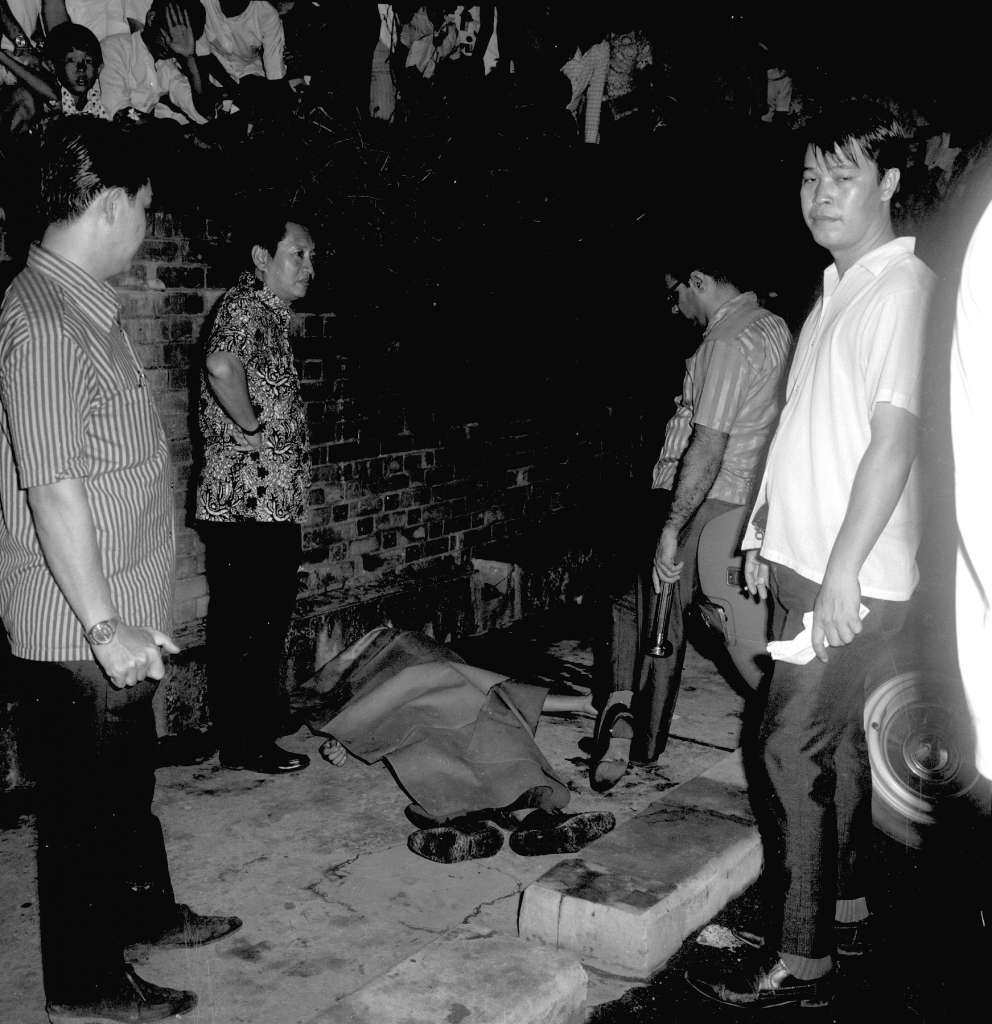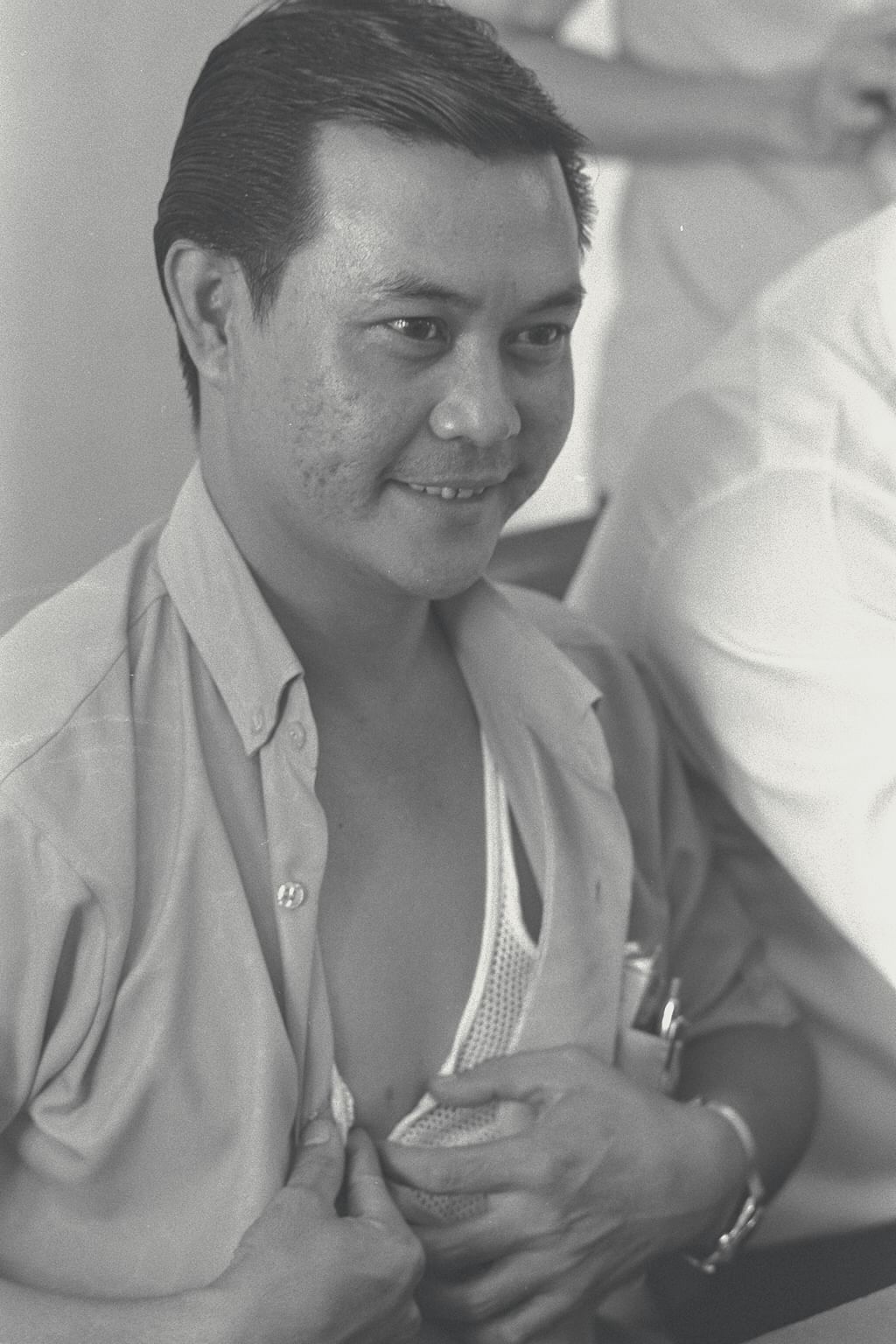The case of Lim Ban Lim (1972)
Guilty As Charged: Lim Ban Lim was most wanted gunman in Singapore and Malaysia in 1960s
The notorious gunman who engaged in Hollywood-style shootings with police met his end in a showdown at Margaret Drive
Sign up now: Get ST's newsletters delivered to your inbox

Lim Ban Lim’s body covered with a tarpaulin after police were finally able to bring him down.
WANBAO FILE PHOTO
Follow topic:
This story was first published in July 2015 in an e-book titled Guilty As Charged: 25 Crimes That Have Shaken Singapore Since 1965. A collaboration between The Straits Times and the Singapore Police Force, the e-book appeared in The Straits Times Star E-books app. Read the other crime stories here. (Warning: Some content in these stories may be disturbing for some individuals.)
The case of Lim Ban Lim (1972)
The notorious gunman who engaged in Hollywood-style shootings with police met his end in a showdown at Margaret Drive
He had gained so much notoriety that after he was shot to death by police, 33 inmates escaped from a reformative training centre just to attend his funeral.
Lim Ban Lim, who was the most wanted gunman in Singapore and Malaysia in the 1960s, met his end in Queenstown in 1972, after being on the run for years.

He was 32 years old, and already responsible for the death of one policeman.
Lim, who had six aliases - Tau Hong Lim, Seow Lim, Ah Seow, Suay Kia, Oei Kia and Ah Oei, had been on the wanted list since 1965, after he shot and wounded a detective at Paya Lebar Road in May that year.
The shooting took place after Detective Peter Lim and another police officer arrested a thug who was with Lim and his companion.
Lim and the companion fled and Detective Lim went after them.
When he caught up with them in a lane off Macpherson Road, Lim snatched the officer's revolver, and opened fire at the detective, whose right finger and right leg were grazed by bullets.
Following the incident, the police looked for information on Lim, described to be Hokkien, about 1.65m and of medium build.
But he managed to remain at large.
A year later, in September 1966, Lim shot another officer, Detective Allan Lee, who had arrested his friend in the lobby of the Odeon Cinema at North Bridge Road. Detective Lee was wounded in the leg.
On June 23, 1968, Lim killed officer Koh Chong Thye, a 27-year-old corporal. It was believed that he had spotted Lim walking out of a shophouse in Rangoon Road at 1.20pm that day. He and two other officers trailed Lim to a vacant plot of land in Owen Road.
There, Lim suddenly confronted them with a Browning automatic pistol and demanded that the corporal hand over his revolver.

Corporal Koh refused, and there was a struggle. The officer broke away and ran behind a parked car. But it was then when he got shot in the chest.
Despite being wounded, he drew his revolver and fired back at Lim, but missed. Lim fired a second shot - this time at point-blank range and aimed at the forehead, killing Corporal Koh.
This was not the end of the drama.
Constable Cheong Yan Soon of the police's Guard and Escort Unit, which deployed armed guards to banks for instance, picked up the dead officer's revolver and began a running gun duel with Lim.
He chased Lim through a maze of backlanes, parked cars, and stalls around Owen Road.
At Serangoon Road, Lim fired at the constable before dashing into Kitchener Road. At this point, another detective turned up and also began firing at Lim, who ran into Verdun Road and then into the adjacent Sam Leong Road.
Lim was able to jump into a taxi and force the driver to take him to Lavender Street, where he disappeared.
Police conducted a massive manhunt for Lim after the incident, and his picture was shown on TV.
Doctors and Chinese sinsehs were urged to inform authorities if a wounded man was seeking medical attention.
During the inquiry into Corporal Koh's death in March 1970, State Coroner Liew Ngik Kee, who returned with a verdict of murder, described the case as a typical "Hollywood-style shooting".

Assistant pathologist Chao Tzee Cheng said that the deceased had three bullet wounds. One struck him in the chest and went through his heart, lungs and stomach. Another hit him in the forehead and brain, and the third, his face.
Soon after the incident, police offered a $5,000 reward for the arrest of Lim. The Criminal Investigation Department also carried out raids to track him down.
Less than a year later, in March 1969, police doubled the reward to $10,000.
On November 24, 1972, police engaged him in a final gunbattle at a pasar malam at Margaret Drive.
Officers from the Rural West Division had a tip off that Lim, who had returned to Singapore after spending some months in Taiwan and Macau, and his "trusted armed double", Chua Ah Kow, would be visiting the night market.
By then, there was a price of $17,000 on Lim's head. He and Chua were wanted by both sides of the Causeway in connection with a series of armed robberies and murders.
At 7.30pm, six police officers laid an ambush and took up positions in the vicinity of Block 6, near Golden City Theatre.

After 45 minutes, they saw Lim and Chua walk to a row of shops across the road. The duo came out of a shop 10 minutes later.
Suddenly, they fled in opposite directions, firing at the police.
Officers returned fire, but had to be extra careful as the road was crowded. Two shots grazed the chest of Detective Tan Lee Keng during the battle.
Eventually, officers shot Lim three times in his body.
He staggered for about 10m, collapsed and died, still clutching the revolver in his left hand. Police later found 13 bullets in his pocket, and $1.40 in change.
Chua fired two more shots at police before managing to escape. During a gunbattle at Tank Road three weeks later, he shot himself dead to avoid being arrested.
Gun laws in Singapore
A string of shooting incidents in the early 1970s played a key role in the introduction of Singapore's strict gun laws.
There was the ruthless Johor-born gunman Tan Chian Lai, who shot himself in the head during a police raid on his Toa Payoh flat in 1970.
In December 1972, the Hassan brothers - Abdul Wahab, 24, and Mustapha, 21 - killed themselves after a shootout with police at a Muslim cemetery in Victoria Street.
The brothers had been running a gun-smuggling syndicate, and after Wahab escaped from Changi prison, were behind a string of armed robberies in a 1.5-month reign of terror.
In April 1973, Detective Ng Poh Hock, 27, was shot and killed by gunman Ng Ah Bai in Geylang. Later that month, the 30-year-old gangster was shot dead by police.
In July that year, there was an even more dramatic shootout.
Police had been on the hunt for 21-year-old Hoo How Seng, who had shot dead Detective Ong Poh Heng in Katong on July 12.
The officer had been trying to settle an argument between a busman and a car driver, when the latter pulled out a gun and fired at point-blank range.
Police later found out that the car driver was Hoo - a henchman of a notorious underworld leader who had been caught, and a member of a gang of armed robbers.
Hoo escaped to Malaysia.
But later that month, six detectives found out that he had returned, and was staying with his girlfriend in a Cavenagh Road flat.
They knew he would be armed and had to draw him out of the flat and disarm him.
One of the officers phoned the flat and warned Hoo to get out as police were on their way.
Hoo rushed out, but the detectives, dressed as noodle sellers and petrol station attendants, were waiting. One officer grabbed Hoo from behind. When Hoo pulled out a revolver, the officer put his finger against the trigger to prevent it from being fired.
Hoo pressed the trigger, breaking the officer's finger, and got loose. He fired three shoots, but all missed. The six detectives closed in and shot him dead.
In November 1973, the Arms Offences Act was passed. Using a gun, or even trying to use one to commit an offence, was made punishable by death.
The first to be caught under the new gun laws was Sha Bakar Dawood. He was sentenced to death in 1975 for shooting and wounding three people at a brothel and then opening fire at police at Thiam Siew Avenue.
Who was Lim Ban Lim?
He launched his criminal career with a hold-up in 1958, when he robbed several thousand dollars worth of cigarettes. But it was in 1963 when the Gi Ho secret society member went from small-time crook to big-time robber.
With three accomplices, and all armed with revolvers, he targeted The Straits Times' printing department at Anson Road. Shots were fired and he got away with $30,000 in payroll money.
His biggest haul in Singapore was probably the $156,000 he robbed from the First National City Bank in Collyer Quay in 1966. Two years later, he and five other gunmen stormed the Treasury in Johor and grabbed $450,000. A police constable was shot dead.
He threw police off by parking a stolen taxi near a landing point from where smugglers were known to take a speedboat to Singapore. It was only later police discovered that he and his gang did not use that route.
In his nine-year crime spree in Singapore and Malaysia, he got away with at least $2.5 million. He eluded police for years because after each major crime, he would slip out of Singapore to take refuge in Malaysia, Indonesia, Thailand, Hong Kong, or Macau using forged travel documents.
He was also described as a master of disguise. Not only did he undergo plastic surgery, he also dressed as a woman at times to avoid suspicion.
He could shoot with either hand and was well respected in the underworld, but those who knew him told police he never trusted anyone, except for Chua Ah Kow.
Lim once told the head of the Criminal Investigation Department over the phone: "You will never catch me. When you are about to arrest me, I will surely engage you in a gunfight. I will use the last bullet to end my life, so you can only collect my body."
It was reported that Lim, who married his childhood sweetheart at the age of 16, left three daughters and two sons.

